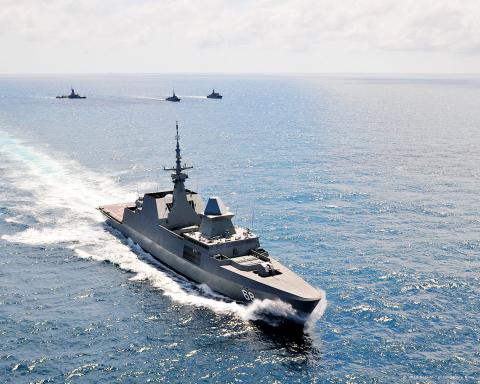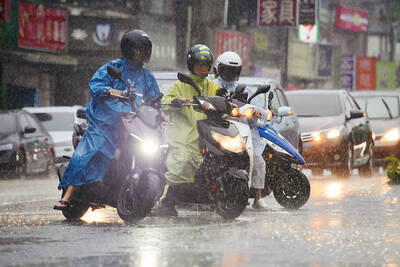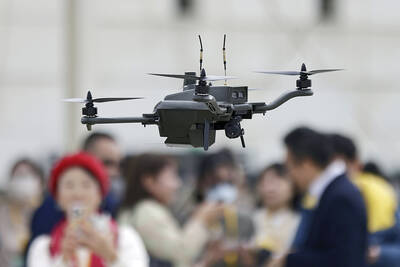The 40-year cooperation between the Republic of China Army and the Singapore Army may be at risk after the city-state sent 70 soldiers to China to an eight-day joint exercise with the People’s Liberation Army (PLA) on Sunday.
The Singaporean soldiers sent to China are from “Project Starlight,” an agreement reached between former president Chiang Kai-shek (蔣介石) and then-Singaporean prime minister Lee Kwan Yew (李光耀) in 1974 and ratified in 1975 under which Taiwan’s military helps train Singaporean troops in the so-called Starlight Exercises.
The government will closely monitor the joint exercises between the PLA and the Singaporean troops, the Ministry of National Defense said.

Screengrab from the Republic of Singapore Navy Web site
Whether the presence of the city-state’s troops at the Chinese military exercise signifies the termination of the Starlight agreement or that Singapore is changing partners from Taiwan to China remains to be seen, the ministry said.
To date, the Singaporean government has not made any changes to the pact and is continuing joint training with Taiwan, it added.
The ministry said it would try to ascertain whether the exercises with China are a one-off event, or if they represent the beginning of normalized joint military training between the two countries.
Ministry officials said that while the Singapore Army joined anti-terrorism exercises with China in 2009 and 2010, there was a significant difference between those drills and a string of recent ones.
Ministry officials said there has been a subtle shift in Singapore’s policy that has seen its army increase dialogue with its Chinese counterpart. The two sides conducted a joint military exercise in April, another in August and in September, the Singapore Army sent a company of troops to conduct joint exercises in the PLA’s Nanjing Military District, they said.
In addition to the increasing familiarity between the Singaporean and Chinese armies, the ministry said the Republic of Singapore Navy has also been reaching out to its Chinese counterpart.
According to the ministry, the Republic of Singapore Navy had sent one of its Formidable-class frigates — a derivative of the French Lafayette class — to attend an exercise with China, adding that as the Formidable-class is an upgraded Lafayette derivative equivalent to the Republic of China Navy’s Kang Ting-class, this interaction could affect future upgrades of the Taiwanese frigates.
The RSS Formidable attended a multinational naval exercise off Qingdao, China, in April, while the RSS Steadfast visited the People’s Liberation Army Navy South Sea Fleet.
The ministry said the nation’s Kang Ting-class frigates are nearing the time for crucial upgrades, which include increasing their vertical missile launch systems and replacing the MIM-72 Chaparral missiles they carry with domestically manufactured Sky Sword II missiles.
The Sky Sword II anti-aircraft missile system can be carried by platforms across all the military’s branches. The Chaparral missiles were originally made to be surface-launched anti-aircraft missiles and were developed by the US Army.
The possibility of China increasing its familiarity with Lafayette-class ships through interaction with Singapore’s Formidable-class vessels is a huge factor in determining if Taiwan’s navy will maintain its current upgrade plans or seek alternatives, the ministry said.

The combined effect of the monsoon, the outer rim of Typhoon Fengshen and a low-pressure system is expected to bring significant rainfall this week to various parts of the nation, the Central Weather Administration (CWA) said. The heaviest rain is expected to occur today and tomorrow, with torrential rain expected in Keelung’s north coast, Yilan and the mountainous regions of Taipei and New Taipei City, the CWA said. Rivers could rise rapidly, and residents should stay away from riverbanks and avoid going to the mountains or engaging in water activities, it said. Scattered showers are expected today in central and

COOPERATION: Taiwan is aligning closely with US strategic objectives on various matters, including China’s rare earths restrictions, the Ministry of Foreign Affairs said Taiwan could deal with China’s tightened export controls on rare earth metals by turning to “urban mining,” a researcher said yesterday. Rare earth metals, which are used in semiconductors and other electronic components, could be recovered from industrial or electronic waste to reduce reliance on imports, National Cheng Kung University Department of Resources Engineering professor Lee Cheng-han (李政翰) said. Despite their name, rare earth elements are not actually rare — their abundance in the Earth’s crust is relatively high, but they are dispersed, making extraction and refining energy-intensive and environmentally damaging, he said, adding that many countries have opted to

FORCED LABOR: A US court listed three Taiwanese and nine firms based in Taiwan in its indictment, with eight of the companies registered at the same address Nine companies registered in Taiwan, as well as three Taiwanese, on Tuesday were named by the US Department of the Treasury’s Office of Foreign Assets Control (OFAC) as Specially Designated Nationals (SDNs) as a result of a US federal court indictment. The indictment unsealed at the federal court in Brooklyn, New York, said that Chen Zhi (陳志), a dual Cambodian-British national, is being indicted for fraud conspiracy, money laundering and overseeing Prince Holding Group’s forced-labor scam camps in Cambodia. At its peak, the company allegedly made US$30 million per day, court documents showed. The US government has seized Chen’s noncustodial wallet, which contains

SUPPLY CHAIN: Taiwan’s advantages in the drone industry include rapid production capacity that is independent of Chinese-made parts, the economic ministry said The Executive Yuan yesterday approved plans to invest NT$44.2 billion (US$1.44 billion) into domestic production of uncrewed aerial vehicles over the next six years, bringing Taiwan’s output value to more than NT$40 billion by 2030 and making the nation Asia’s democratic hub for the drone supply chain. The proposed budget has NT$33.8 billion in new allocations and NT$10.43 billion in existing funds, the Ministry of Economic Affairs said. Under the new development program, the public sector would purchase nearly 100,000 drones, of which 50,898 would be for civil and government use, while 48,750 would be for national defense, it said. The Ministry of